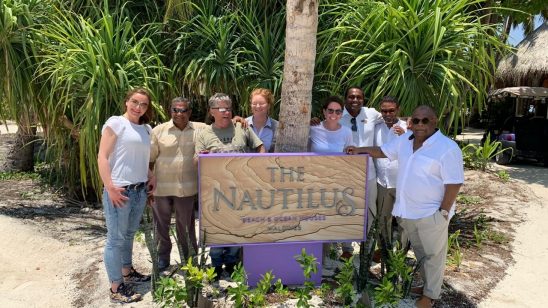
Tourism Indicators: Hope and Recovery amid the Pandemic


The year 2020 began with hope and positive expectations for Maldivian tourism industry, achieving a monthly growth rate of 14% in international tourist arrival for the month of January compared to January 2019.
Yet, within just few weeks, the outbreak of the Covid-19 pandemic led to an immense global health crisis, worldwide panic, uncertainty and extremely unprecedent economic shocks. With the exponential spread of the virus, the World Health organization declared a global pandemic situation on 11th March. Among the many industry sectors, the tourism sector is one of the most tragically hit, and the once thriving global travel and tourism operations felt a complete standstill. The repercussion of worldwide measures to contain the virus by closing of borders and locking down of major cities around the world brought the travel sector and several related industries to a temporary halt. And, Maldives was one of the hardest hit economies due to its overdependency to tourism, and the economic shock was much deeper to the country.
Arrivals Trends
Amidst the global lockdowns, border closures and travel restrictions, UNWTO World Tourism Barometer December 2020 reported that the international tourist arrival plunged by 72% from January to October 2020 compared to the same period in the previous year. According to UNWTO, it was a decline of 900 million international tourists which had also resulted in a loss of export revenue from international tourism by US$ 935 billion for the same period. UNWTO also forecasted an overall year-over-year reduction of 1 billion international tourists, and a loss of US$1.1 trillion in international tourism receipts for 2020. Further, the report stated that the Asia and the Pacific region experienced the sharpest decline (82%) in international tourist arrival, and the overall demand for travel is still shallow as the pandemic continues.

As the spread of Covid-19 advanced, Maldives took similar measures like many other countries, implementing travel restrictions, banning on-arrival visa to international tourists, and subsequently closing the borders on 27th March. Those drastic but necessary strategies implemented to control the pandemic by the Maldives and by several other countries across the globe crippled the key economic sector of the country. However, the Government of Maldives reopened the border in mid-July, with phased out opening of tourist facilities, along with testing and other precautionary requirements to ensure the health and safety for both visitors and locals. And, although the number of inbound international tourists were low at the beginning of the third quarter, the fourth quarter depicted impressive growth on tourist arrivals. A total of 555,215 international tourists visited Maldives in 2020, which yet, is a year-over-year decline of 67%.
As for the rest of the key indicators, the occupancy rate and the bed nights followed a similar pattern with the arrival figures. The average duration of stay excluding the duration where the border was closed for international tourists stood at 7.8 days. The operational bed capacity also dipped along with the demand side indicators reflecting the closure of the majority of tourism operations and facilities.
Demand Trends, Demographics and Source Markets



Looking at the geodemographics, after the recommencement of the sector, from July to December 2020, some differences were identified. The two major source markets to the Maldives, China and Italy are not among the top 10 list, while Russia made it to the number one, and India maintained its position as the second with an increased share after tourism recommenced. Additionally, UAE, Khazakstan, Ukrain and Spain moved up to the top 10 list for this period while the number of inbound tourists from Australia and japan reduced. Observing the arrival patterns for the whole year, India is the top market for the Maldives, followed by Russia, and United Kingdom. China- the number one source market in 2019 moved down to 6th in 2020.
Other key trends
Furthermore, although most of the commercial airlines were grounded during the pandemic, an exponential growth in the number of private jets landing to the Maldives were seen as the tourism industry resumed. Covid has created an upsurge in the global private jet charter market, as travelers, even the middle class, are more concerned with safety and social distancing, making private jets not just a means of travel for only the elite. In the Maldives, in addition to the Velaanaa International Airport, private jets are welcomed by other regional airports including Addu, Kooddoo, Kudahuavdhoo, and Maafaru Airport.
Supply side: Tourist Accommodation Capacity



With the lockdown and closing of the border, almost all tourist accommodation facilities were closed down during the second quarter, however, since tourism resumed in July, the facilities reopened gradually. Amongst the registered facilities as of December 2020, 142 (32792 beds) out of 167 tourist resorts were operational, 11 (1,458 beds) out of 13 hotels were operational, 257 (5,028 beds) out of 631 guest houses were operational, and 133 (2,576 beds) out of 159 safari vessels were operational. And a significant number of guest houses are still closed as guest houses outside Male’ region were only allowed to reopen on 15th October, due to the Government’s approach to pace out the reopening of tourism facilities as a measures to contain the virus spread within the atolls and inhabited islands.
The devastating ripple effect on the economy

As over 70% of the GDP flows from tourism and related industries in the previous year, a ripple effect was seen in the overall economic performance. GDP plunged sharply by 51.6% in the second quarter of 2020 compared to the same period in 2019. With a moderate growth scenario, an overall decline of 29.3% in real GDP is projected for 2020, while a positive GDP growth of 13.5% is projected for 2021.
Success amid the crisis
Despite the grim situation and the various challenges faced due to pandemic, Maldives tourism sector achieved remarkable accomplishments in 2020. For the first time in history of the Maldives Tourism industry, the country won the most distinguished award- “The World’s Leading Destination” at the Grand Final of the World Travel Awards 2020 held virtually on 27th November. Maldives also won several awards in several other categories.
- Indian Ocean’s Leading Beach Destination 2020
- Indian Ocean’s Leading Cruise Destination 2020
- Indian Ocean’s Leading Destination 2020 (a title won for the 13th time)
- Indian Ocean’s Leading Dive Destination 2020
In addition, the island nation was also nominated for 40 other categories at the Grand Final and several tourist properties won awards in these categories.
As several marketing activities to promote the tourism sector were undertaken during the year, these success indicates the immense effort undertaken by the government and other key stakeholders in reviving the sector.
The aftermath and outlook
With the pandemic, some notable changes in the behavior and preferences of the travelers are being observed. The WTTC report- “The Future of Travel and Tourism in the wake of Covid-19”, highlighted that travelers now opt for more familiar destinations which are in close proximity to their homes within the country or within the region. Also, that visitors give more preference to beach, nature and outdoor or rural areas, and now average duration of stay is longer than the pre-pandemic period, and they require more flexibility in travel bookings. In addition to such evolutions in demand, other new trends in the travel sector emphasized in the report include increased focus on health and hygiene, rise in adoption of innovation and digital technologies, and more concern on sustainability.
At the face of these new trends, the outlook seems positive for the Maldives as more tourists tend to prefer rural and beach destinations away from crowds. With the one-island-one resort concept established by the Maldives, there is a clear competitive advantage to the island nation as Maldives can offer a more safe and secluded vacation. This unique selling point with joint collaborations of the government and key industry players, is expected to bring a brighter future and a quick recovery to the hard-hit sector.
Main Photo : Niyama Private Island





